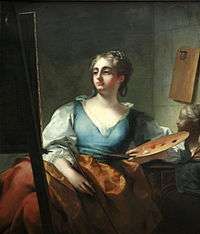Claudio Francesco Beaumont
Cavaliere Claudio Francesco Beaumont (4 July 1694 – 21 June 1766) was an Italian artist, born in Turin.[1]
Life

Beumont was born in Turin on 4 July 1694.[1] Little is known of his early youth, besides the news on education in school of grammar and rhetoric, of architecture and mathematics, directed by the Jesuits. The first documented news refers to a trip to Bologna, where he stayed from February to December 1716, and where one can deduce that he conducted studies in the churches of that city, with attention to the paintings of the late seventeenth-century local academy (Cignani). In December of the same year he was in Rome, and a letter addressed to his brother documented that he was at the school of F. Trevisani, who would have a great influence on him. The reports of the ministers in Rome to the king of Sardinia proved that he enjoyed, even in that city, the protection of the sovereign. In the interval between the return to Turin (1719) and the second Roman stay (1723) the painter receives commissions for the Turin Palace; among these is a ceiling with the Aurora on the second floor of the building. In 1723, after having been prior of the confraternity of St. Luke in Turin, he returned to Rome where he stayed until 1731. [2]After studying in his native city, he went to Rome, where he copied the works of Raphael, the Carracci, and Guido Reni. He appears to have had little respect for the Roman painters of his own time, except for Trevisani, whose manner he imitated in the vigor of his tints.[3]
His fervent activity for Piedmontese castles was documented: for Rivoli (1724-25: St. Giovanni Battista and St. Pietro) and for the Royal Palace.
In 1724 the king of Sardinia recommended him to Wleughels, director of the French Academy in Rome, who was passing through.
In 1725 he became a member of the Accademia di St. Luca in Rome. Of 1727 it was document that he received a grant of 2000 lire per year, first step for the nomination as court painter, which will take place in 1731.
In 1727 a serious illness obliged him to make a pause in his artistic activity and to take some rest and the king helped him with a bonus. This year Elena (now lost) was documented for the castle of Rivoli. The repertoire of Beaumont was formed in these years, taking advantage of the iconography that was dear to Trevisani, as is recognized by the subjects of Sofonisba executed according to the canons of Marattism (first sent from Rome in 1729, in Palazzo Madama, Turin, up to 1800, and then in private collection).
In 1730 the King insistently called the painter to Turin, for decoration. But Beaumont was finishing the Blessed Margaret, destined, as well as the St. Carlo That Communicates About the Plague Victims, to the church of Superga.
Together with the Deposition for St. Croce, Turin, the paintings for Superga recall the taste of the maritimeism that was prevailing in the Roman and Neapolitan churches, with references to G. Brandi, S. Conca and Trevisani. In July 1731 Beaumont was appointed a court painter.
In 1736 the painter was appointed knight of the order of the Saints Maurizio and Lazzaro.
On 22 March 1737 the painter was sent to Venice to negotiate the purchase of paintings and here he made contact, most likely , with painters already active for the overhangs of Palazzo Reale, like Sebastiano Ricci and Giambattista Pittoni, who would influence the subsequent development of his style.
Meanwhile, the painter is active for the churches of Piedmont: in 1740 the altarpiece representing the Blessed of Chantal and St. Francesco di Sales for the monastery of the Visitation of Pinerolo.
In 1755 the painter began the great altarpiece for the church of the Carmine of Turin, with the Blessed Amedeo, which would be placed on the altar in 1760.
On the 21st of June 1766 the painter died at the age of 72 and is buried in the church of St. Teresa on June 22.[2]
Among his pupils are Vittorio Blanseri and Giovanni Molinari.[4]
References
- 1 2 "Beaumont, Claudio Francesco" Dizionario Biografico degli Italiani, A. Griseri, (in Italian). Accessed 2011-05-15.
- 1 2 Griseri, Andreina. "- Dizionario Biografico degli Italiani - Volume 7 (1970)". Treccani. Retrieved 8 March 2018.
- ↑ Bryan 1886
- ↑ Dizionario ragionato delle voci delle arte del disegno architettura, pittura, scultura ed industrie affini, (1888), by Giuseppe A. Boidi, page 417.
Sources

Further reading
- Cifani, Arabella; Monetti, Franco (2007). "Contributi documentari per il pittore torinese Claudio Francesco Maria Beaumont (1694-1766)". Storia dell'arte (116-117 (n.s. 16-17)): 203–248.